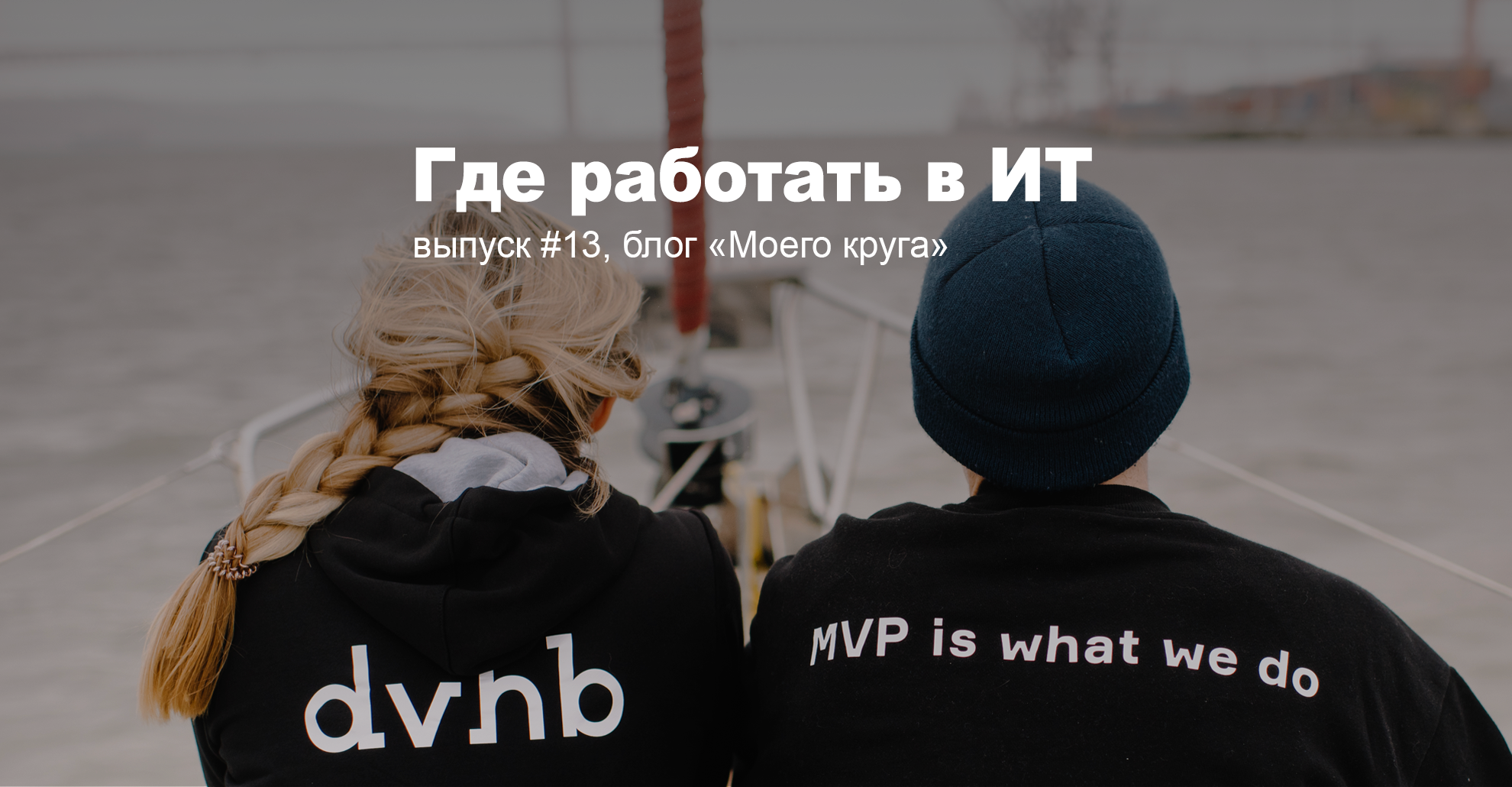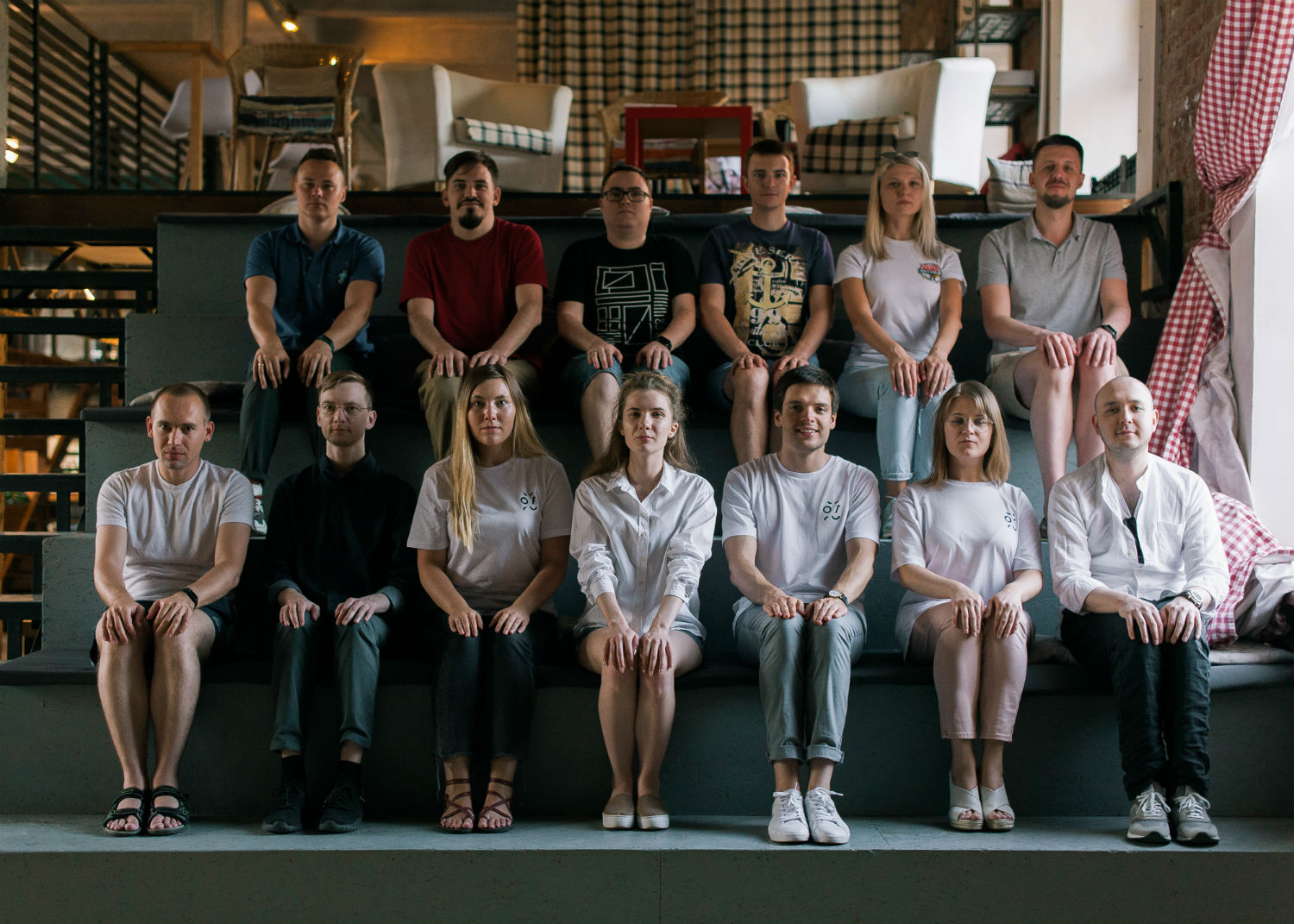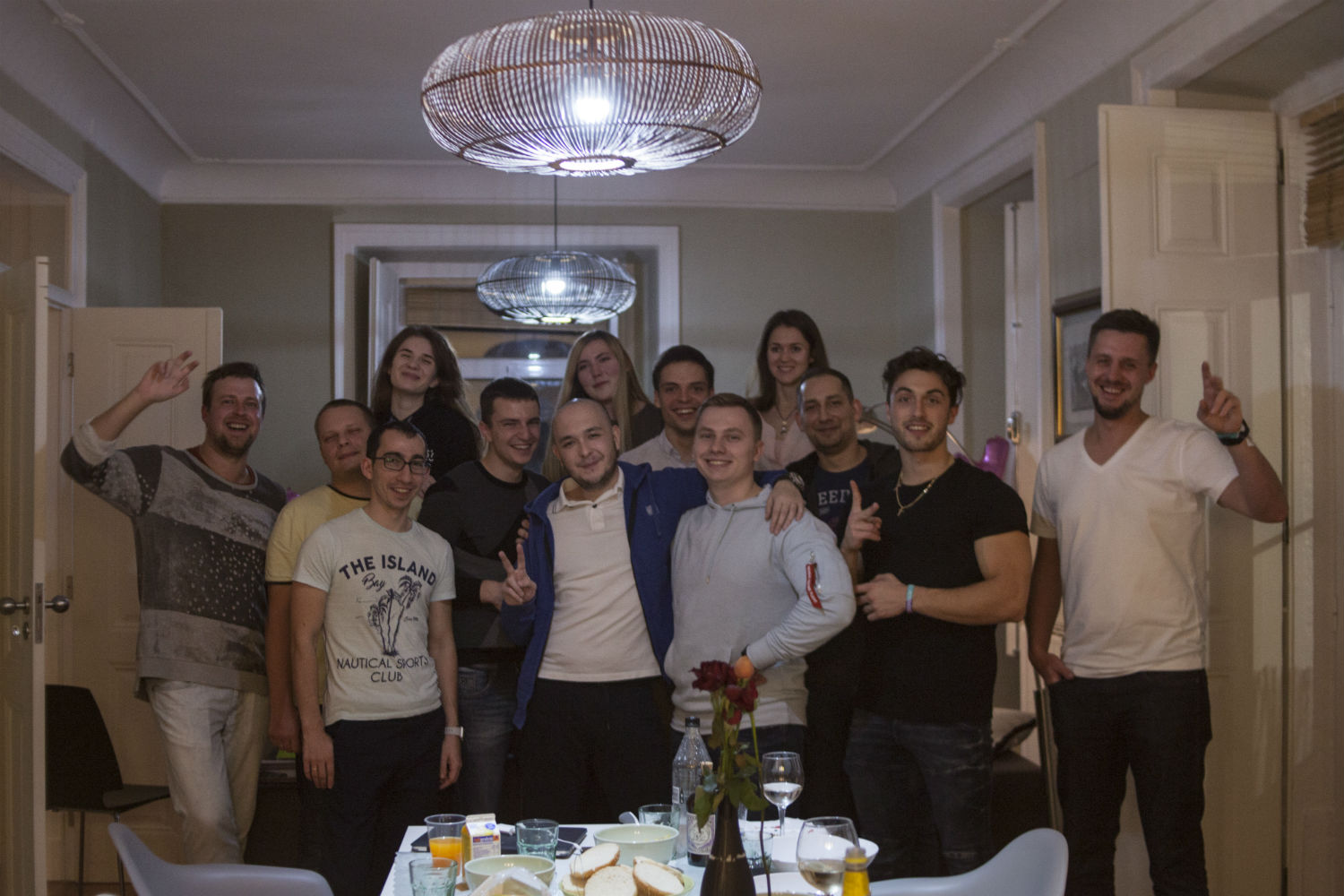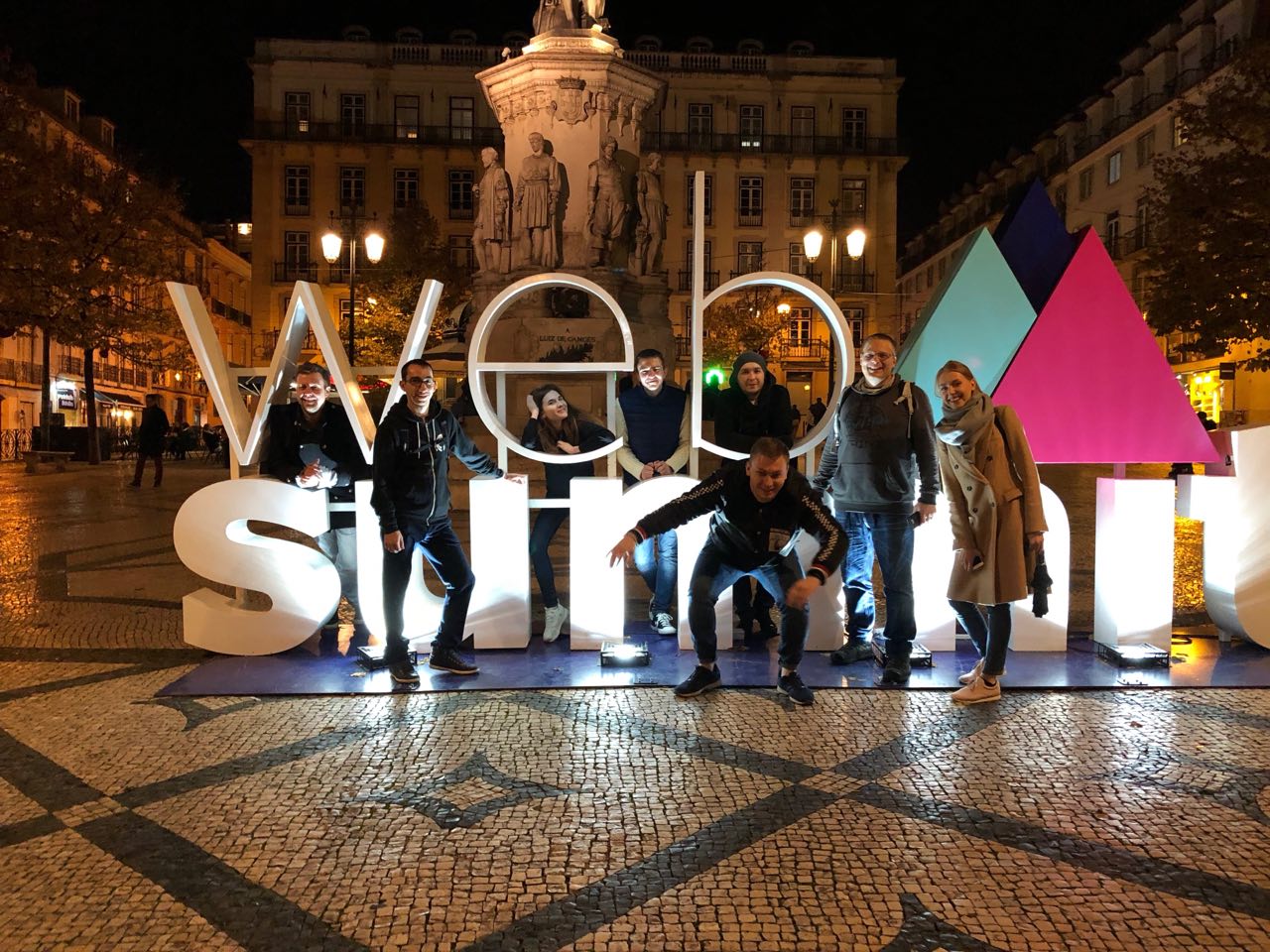In the office there is an illusion of control - it is not on the remote. Conversation with Devhab

Soon, the convenience of remote work will fall into the list of topics that it is better not to discuss with strangers - along with politics and religion. As for her, they do not agree in any way. Some managers say it’s high time to cancel the offices, and soon the industry will do so. Others are the other way around - the industry has become disillusioned and convenes everyone back under one roof.
There is a moment of unity in the dispute: a remote approach needs a special approach, certain qualities, and not everyone can cope with it.
We talked about this and not only with the Devhab company , which solves the problems of the remote site by seeking a balance between strict rules and the informal environment.
Devhab received an average rating of 4.56 and an average recommendation of 93% of his employees on My Circle. He is appreciated for the modern technologies that are used in the work, for excellent relations with colleagues and forged communication with top management.
What started the Devhab
In the mid-zero, when trading on the Internet was still something exotic, Alexander Samsonov opened a pet shop website. He studied with him for three years and then sold it to graduate. Having worked as an online sales sales manager, he decided to open his own consulting firm.
“In the early 2000s, e-commerce was actively developing, and I understood that there are not enough heads of online stores in the country, and companies would like to enter the market. Therefore, I took up consulting and began to lead several projects, ”says Alexander.
For a new business, he was looking for a modern-minded accountant who would understand in distance trading. The man whom Alexander found, thought even wider - he himself was looking for developers for one complex project. So the company, which was later called Devhab, had the first order.

“The project was called“ Stream FM ”. The customer in 30 cities of Russia hosted servers with multi-channel FM tuners, which collected data from 27 radio stations around the clock. With their help, we had to create a radio broadcast monitoring system so that advertisers, launching advertisements in several regions, could monitor where and when it sounded. ”
The system had to analyze the data, compare them with the standard, look for discrepancies on the air and determine their nature. The team wrote and designed the interface for the client, the entire server part, which worked with raw data - but the team consisted of only four people.
“It was a difficult project. He came first, and quite by accident, and we, of course, underestimated him. It took a long time, and we earned less than we wanted, but we learned a lot. On this project, we have formed an approach to technology and architecture, which we have been following all these years. It was then that I realized that development is more interesting to me than Internet commerce. ”
But this was only the first complex project that did not meet all expectations. For several years, the company barely survived in the market and was looking for its place.
“It was difficult to survive, so we took on everything. We made corporate websites, worked on subcontracts for advertising agencies. Until 2013, they took large projects, and every little thing. Only in the fourteenth year did I feel a certain turning point. Perhaps by then we had finally figured out how to work in this market. Then we learned how to sell ourselves by Time & Materials ”

How the team works now
Now in the Devhab there are about forty people working on more than ten projects. The company is now engaged in both development and consulting - but not the way Alexander wanted at the very beginning. They advise on how to properly develop an IT product.
“We often act as technology partners for entrepreneurs. Their head hurts about business and sales, and they delegate technical and product questions to us. We can say that we specialize in the development of new startups. If everything goes well and takes off, we support the product, and in a year or two we help the customer to assemble his own team. ”
Alexander describes the work as follows: his team forms a development strategy - starting with MVP, ending with how to launch the product, spend money correctly, collect feedback and move on. “After we have formed the business part, we write specifications, technical specifications, we begin designing the interface, then design. In parallel, we can begin development. ”
Rotation culture
The hackathon atmosphere reigns in the approach to projects - this is how its front-end developer Igor Deryabin describes it. “Our teams gather as friends between friends. The atmosphere is informal and friendly, despite the fact that there is a requirement to do the job well. ”
The team includes an account that communicates with the client, collects requirements and discusses working conditions. Behind him is a project manager who distributes these requirements among developers, manages release plans and rolling out projects. He is actually the technical director who is responsible for architecture, integration, quality, documentation and at the same time manages the team.
For each project, two leading developers are appointed - techlida. One to the backend, the other to the front. Techlides take on two or three developers. “In the process, people can change. When the process is stabilized and the framework of the main features is ready, the lead developer can move on to the next project and leave his legacy to another. ”
Such a system has very strict code requirements.
“When a new developer comes to the project, the first few weeks they constantly review it. When it is mastered, they do it less and less. With this approach, it is still possible to keep the code base intact.
All that can be done without hands, we try to automate. We have templates for quick deployment of the project, there are templates with ready-made structures so that all projects are on the same platform. We try to unify projects as much as possible - we bring everything that is possible to a common standard. "

Which technologies are used in Devhab
Over the nine years of the company's existence, some technologies have steadily developed, others have come and gone. The frontend has become much more difficult, sometimes it led to trouble.
Frontend - React and TypeScript
One of the projects Devhab started doing on the first Angular, when React was not well known. The customer of the product looked at the progress, showed it to potential customers, asked for something to change, again showed it - and so for several years. During this time, the first Angular managed to become a thing of the past. “It was very difficult for us to find a developer to support and develop this solution. On the other hand, rewriting it was even more expensive. But I will not say that it was a fail or a miscalculation - we became hostages of a technological revolution. ”
Now the frontend team is the largest in Devhab. They try not to miss trends, track prospects, listen to the industry and constantly experiment. In recent months, for example, developers have been eyeing Flutter, a framework for developing hybrid mobile applications. "Now he can become a serious competitor to React Native, so we are looking for a project on which we could experiment." In a similar way, Devhab made React his main tool in 2016 - introduced it for testing on one of the projects, because the library seemed promising.
Backend - Django + Asyncio
The backend from the first project and to date Devhab writes in Python with Django. For the past three years, the team has been using Django only as an ORM and administration system. With Asyncio, the team makes all backends asynchronous.
They do not see any prerequisites to leave Python, and even wrote the DVHB Hybrid tool to make friends with Django and Asyncio.
Devhab never looked in the direction of Java, nor Go, nor .NET. Alexander expressed interest in Rust, although he has not yet been tried. “You can write on anything, even on Pascal. You need to use a stack that you own and that is popular with the community. It’s important that the technology is relevant for the next three to four years, that libraries are released for it, and that there is a community that can help, and that there is someone to hire. ”
Mobile development
Devhab makes mobile applications on the web stack and believes that in their area you can do without native development. “An unprofessional look does not see the difference in the final product. But at the same time, the cost and development time are significantly reduced. When a bank arrives that needs a very cool mobile application, they certainly need a company that does native mobile development well. On the other hand, we know how to make a good interface and give it to someone for native development. ”

How to control remote work
In 2012, the Devhab team abandoned offices and has since been distributed throughout Russia and several foreign countries. When asked if it is harder to control such a team, Alexander says that on the contrary it is easier than a single office.
“We believe the remote control system is much more efficient. You come to the office, you see that people are in place, and you think that everything is fine. It creates the illusion that everything is under control. And when everything is remote, there are no illusions. There are problems that can be solved in certain ways. ”
And the main problems in the remote site are known - control over working time and employee interaction. In Devhab there are two main solutions.
Working hours and availability times are two different things.
People discuss in advance how many hours they will work next week, but when they work out they decide exclusively for themselves. To ensure that no one depended on someone else's schedule, they introduced a separate availability time from working hours. For example, from ten to six in Moscow every day, an employee simply keeps a phone nearby, and in case of which he can answer a message in Slaka. It works - when it is convenient.
Hourly rate and time logging
In Jir, Devhab has everything for which there are tasks in which the timer starts, and the time is fixed to the nearest minute. The estimated time for each task is determined in advance by leads and managers. They adjust the assessment in the process if circumstances change. Then once a week and once a month, the guys watch who worked how much and calculate the payment at the hourly rate. Managers guarantee that there will be enough tasks for a full load, but how much to work, employees decide in advance themselves.
For managers, there are special tasks that open for the whole week - such as "general management of the project." According to Alexander, the first time logging was introduced due to the format of work with the customer. “They pay for time, they have transparent reports, access everywhere - in Jira, in Gitlab. Everything that a team member has pledged is also seen by the customer. ”
“Of course, working with a timer is a bit specific,” says Igor, “It requires more discipline. You need to control yourself how much time has already spent, how much is left. But it seems to me that this is more likely to benefit than harm. You yourself have an adequate assessment of your performance, plus everything is transparent to managers and the customer. ”

How to build a team and fight burnout
But not all problems removed are solved by formal rules. Sometimes they are deeper.
“Some people are faced with remote work for the first time and suddenly realize that they don’t know how to deal with it,” says Anna Degtyareva, eychar manager at Devhab. She is among such people, because a year and a half ago she came from an ordinary office, not believing that the eychar could be remote. “When you are in the office, it’s easier for you to get in touch with the team. You see everyone every day. When you communicate in person, you quickly recognize a person. Here, at first, I had to force myself not to worry about this. ”
For Alexander, the psychological education of Anna has become a plus, although, as she says, business sometimes treats this with prejudice. “There is an opinion in the market that psychologists are more fond of talking than doing.”
However, the lack of communication between employees - even ordinary conversations - leads to big problems, especially on the remote. People become isolated, do not receive feedback, cannot evaluate their contribution, do not know what to do with problems, start to inflate these problems in their heads, burn out and finally drop out of work.
“It is more difficult for a remote team to feel like a team. We are trying to work on this constantly, ”says Anna.
Mentoring
For example, now Anna is introducing a mentoring system so that a mentor is attached to each employee. “It will be like a confidant within the company. A person who will definitely see changes in mood will always be up to date with your affairs. And if he finds a problem, he will be able to inform me or the lead, and we will try to help the person. "
Weekly Newsletter
“Every week, no matter what happens, at four in the morning, Moscow time, a letter is sent to all employees containing news of the Devhab, stories and stories of colleagues, summaries, statistics, photos with seals and selections of fresh memes. It takes a lot of resources, but everyone loves this newsletter. A lot of people participate in it - our editor and all employees who want to write something. ”

Employee Assessment
Another project was initiated by employees who lacked feedback from colleagues and managers. “Now we are trying to implement a rating system for each employee - we compiled a questionnaire and sent it to the guys who worked with it. They give grades, some questions are answered in a detailed manner. When the data is collected, we assign a call to the employee, where we analyze the answers and formulate recommendations. Six months later, we will conduct another iteration of the survey and see what recommendations worked, what improved. And if not, understand why. ”
But conversations alone really do not always help - sometimes actions are needed. “You won’t do anything in one conversation. If a person can no longer work, then no matter how much you communicate with him and do not motivate, the effect will be short-term. He will wake up tomorrow and the pains will be the same. ”
Constant change of projects and roles
“We love employees, and we rarely have cases when we decide to diverge. We prefer to guide the guys. Therefore, we move employees from project to project. It works better. "
" With burnout, I have my own story. Last summer, we had a tense situation in terms of development, ”says Igor,“ I was then responsible for almost the entire frontend on the project. It was hard to be in tension all working day for several weeks.
After that, I switched to another project, and yes, it helped. Change of activity is the best rest. Change of subject area, pace, environment - all this helps to unload the head.
But elementary communication with colleagues helps. I concluded for myself that it is easier for me to work when I have friendly relations with my colleagues. When I can chat informally with the manager and I know that he is not above me in the hierarchy, but a member of the team like everyone else. In this regard, I like how everything is arranged with us, that no one is standing above anyone.
We seem to be divided into teams, but in Slack all the same all together. "

How employees stick together
Devhab has a tradition of visiting cities where at least one of their employees lives. Since the team is very distributed, the meetings are held according to the following principle - they select the city where the company employee lives, gather there and spend several weekdays and weekends to work together and see the city.
“During the year we have already visited five cities - Kazan, Kaliningrad, Lisbon, Krasnoyarsk and Rostov-on-Don. Periodically, the guys come to Moscow. There were also small working congresses in Paris and Barcelona.
Of course, not all forty people travel. On average, it’s about ten to fifteen, but always different. Because more and more people are taking the initiative and are joining us. ”
“The last mitap was not only ours. In Rostov coworking, we held a remote work meeting with another company, ”says Elina, marketing manager at Devhaba.“ I think we will continue the same way - combine team meetings and meetings with the local community to communicate more and develop a culture of remote work.
It is rare that unfamiliar teams come together and share experiences and just invite those who work around. I know that Skyeng in Moscow has such an initiative. But in the regions we have not seen this. And the peculiarity of remote work is precisely in this - you are not limited to the market of one city. It is very interesting for us to communicate with the community in the regions and tell everyone: “look, you can live in your city, and at the same time not be limited to local companies only.”
